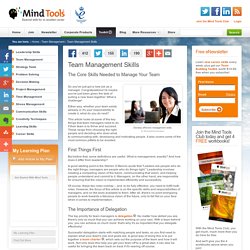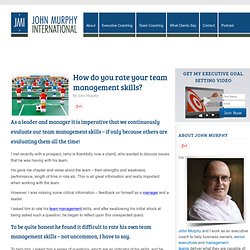

The team leader's role. What are the critical knowledge and skills for a team leader?

Team diagnostic knowledge and skills – observing and understanding team dynamics and team development Team leadership and intervention – knowing how and when to respond to the team, given the team’s stage of development Interpersonal and team skills – establishing effective team processes in the areas of alignment, decision making, communication, problem solving, conflict management, performance measures, values and norms An effective team leader will Create a positive climate with a shared vision Help develop a set of principles Liaise between the team and upper management Encourage team member growth Be fair Be supportive Give direction where needed. There are several ways in which the team leader can contribute to creating a positive climate within the team. One of the most powerful forces is to put forward, in cooperation with team members, an exciting vision/purpose of what the team is to achieve.
9 ROLES of a TEAM LEADER - How To Become a Great Team Leader. ① Provide purpose.

Everything starts with → vision. You cannot have a real team without one because people will not find the desire to achieve the common goal. The team members will work together and sacrifice only if they can see what they're working toward. Leading Team Development. I think the Army would make a serious mistake if we made a distinction and said, “You are a manager, and you are a leader.”

So my philosophy is that we are all leaders! We also must be responsible managers or stewards of resources entrusted to us. We would make a serious mistake to think that we could be one and not the other. — General John Wickham. Leaders should not think of themselves as simply managers, supervisors, etc.; but rather as “team leaders.” 6 Essential Leadership Responsibilities that Build Effective Teams. By Jeff Wolf Everybody in business, at one time or another, and probably more than once, has witnessed the results of poor leadership: listless and confused employees leading to stagnating sales, excess costs, and crumbling profits.

It happens at every level of the organization, from frontline supervisors right through the top echelons. Teamwork is key, but it doesn’t happen automatically. Team Management Skills - Team Management Training from MindTools.com. The Core Skills Needed to Manage Your Team Develop effective management skills. © iStockphoto/Andresr So you've just got a new job as a manager.

Congratulations! Or maybe you've just been given the task of pulling a new team together. Either way, whether your team exists already or it's your responsibility to create it, what do you do next? Managing Individual Team Members. Maintaining Team Performance. Building Your Team's Morale, Pride, and Spirit. This guidebook is available for eBook purchase and download from Apple's iBookstore; Amazon's Kindle; Google eBooks; Sony iStore, and other reputable distributors of eContent.

A Free Membership That Supports Your Leadership Needs - Join and Save Did you know that you can join the open and always-free myCCL at no cost and get a discount on this CCL Press Publication? CCL provides myCCL members with a 5% discount on CCL Press Publications like this just for being a member. Membership is complimentary in order to support our non-profit goal of connecting a world community of leaders and providing the best in leadership and leadership development for the benefit of societies world-wide. Join the always-free myCCL online community and get access to this discount along with a host of resources to support you or your organization with its leadership needs. Raising Sensitive Issues in a Team. This guidebook is available for eBook purchase and download from Apple's iBookstore; Amazon's Kindle; Google eBooks; Sony iStore, and other reputable distributors of eContent.

A Free Membership That Supports Your Leadership Needs - Join and Save Did you know that you can join the open and always-free myCCL at no cost and get a discount on this CCL Press Publication? IQ Management - Creating A Winning Team Mentality. How do you rate your team management skills? I met recently with a prospect, (who is thankfully now a client), who wanted to discuss issues that he was having with his team.

He gave me chapter and verse about the team – their strengths and weakness, performance, length of time in role etc. How to build a stellar organization. How to Launch a Team: Start Right for Success. This guidebook is available for eBook purchase and download from Apple's iBookstore; Amazon's Kindle; Google eBooks; Sony iStore, and other reputable distributors of eContent.

A Free Membership That Supports Your Leadership Needs - Join and Save Did you know that you can join the open and always-free myCCL at no cost and get a discount on this CCL Press Publication? CCL provides myCCL members with a 5% discount on CCL Press Publications like this just for being a member. Membership is complimentary in order to support our non-profit goal of connecting a world community of leaders and providing the best in leadership and leadership development for the benefit of societies world-wide. The Single Largest Collaboration-Killing Mistake You’re Unaware Of. There’s a lot of talk about how to get the most out of teams today. Do you define strict roles for each team member? Is it all about outlining the approach? Do you let teams naturally work to achieve it? How much structure is too much when it comes to collaboration? Team Leaders Need Better Data, Faster. Study performance inside any organization and one finding leaps out at you.

It’s one of those revelations that is at once obvious and surprising, the sort of discovery that’s as clear as day, and yet makes you realize that you’ve never seen it written about in the business press. This discovery is range—that is, variation in performance between two teams in the same organization doing precisely the same kind of work. Whether that performance is measured as per-person productivity, quality, employee engagement, customer satisfaction, accidents on the job, or lost workdays—and even if you study highly controlled environments, such as retail or manufacturing, in which each “team” has been carefully constructed to do exactly the same job in exactly the same way—you still find significant range in the performance metrics. Your team leader is the one who makes the difference. Intuitively, we all know this. Take employee engagement as an example. Weekdone weekly progress reports for managers and internal communication for teams. How to Track the Team’s Mood with a Niko-niko Calendar » Agile Trail.
Example of a Niko-niko Calendar for Teams You can track a lot of stuff in Agile projects, like lead time, velocity, bugs and so on. Tracking those metrics helps the team to identify problems early and without them it’s harder to improve. The faster you can get those numbers, the faster you can analyse them, look ahead and steer the project in a better direction. This is all about tightening the feedback loop. The faster you get feedback, the faster you can react. Feelings are the fastest feedback I know. Emotional Contagion Can Take Down Your Whole Team. We had hired a new senior executive.
Soon after settling in, he began to share his concerns with me. He was doing so, he assured me, only because he loved working for us, and he was looking out for the wellbeing of the company. He reported to me, and at first, I appreciated his input. Early on, he focused on small things, such as pointing out that he thought someone had spent more money than was warranted on a particular project. Then, he remarked on a couple of people who weren’t arriving at work on time. Over time, he let me know he felt people were taking advantage of me. Creating successful teams by building on strengths. Make Sure You're Not De-Motivating Your Team.
The Power of Asking Your Team for Feedback As leaders, we are usually required to give feedback to our team members on a regular basis. But it can often be challenging to get the feedback we need to grow. The more senior our position, the more challenging it can be to get feedback. Of course, most of us receive lots of feedback from our direct supervisors about how we're performing.
This feedback is crucial for ensuring that we're on track to leading our team to achieve the goals that are important to our organizations. Just as important, and perhaps even more so over the long-term, is to get feedback from our team members on how we're doing as leaders. In many cases, especially in organizations in which senior leadership "manages by the numbers," by the time we get feedback from our supervisors it's very difficult to get things back on track.
By the time the effects of an average or poor team culture can be seen in the numbers, transforming the culture might be a significant challenge. Five Questions You Must Ask Your Team. Measuring employee engagement is essential for companies that want to perform at their peak. A Note About Introverts and Teams. Create climate constructive debate.
Let Employees Choose When, Where, and How to Work - HBR. A sense of freedom — the ability to choose what you work on, as well as how, when, and where you perform your work — is a growing priority for talented professionals across sectors and industries, and one of the core elements of a fulfilling career. According to a 2009 Forrester report, by 2016, 43% of the U.S. workforce — 63 million people — are expected to work from home; 34 million people already do. This trend is driven by a number of factors, including professionals’ desire to have control over their day-to-day work life. Millennials are especially keen (as many as 92% in one survey) to eschew office life for more freedom about where and when they work.
But it’s not just workers who benefit from freedoms like working at home. Companies that officially allow employees to work remotely at least three times per month were more likely to report revenue growth of 10% or more within the last year, compared to firms without such policies. 1. 2. 3. How to Hire and Build a Remote Team. Over the course of Zapier's 34-month existence, we've grown from three founders cramped in a small apartment to a team of 16 around the world. 5 Tips to Manage a Team Across Multiple Time Zones. How do you keep engagement, organization, and unity across a team spread out over multiple time zones? If you're having a hard time managing a global team, take some tips from an expert. In Harvard Business Review, Donna Flynn, an executive at office furniture company Steelcase, offers her global company's best practices. "At Steelcase, we all understand that the rhythm of a global team is not a perfect 9-5 melody.
But understanding something can be very different from living it. My team has grown increasingly distributed across multiple time zones and regions of the world over the last couple of years, and we have learned, through experience and experimentation, a few ways to leverage the value of a global team while also minimizing the pain and disruption it can create for us as individuals," she writes. Below, check out Flynn's five tips to manage your global team. 1. 2. 3. It's also important to be on the lookout for new collaboration tools. 4. 5. Five ways you’re hurting your remote working relationships. Let’s be clear. Is Your Team Too Big? Too Small? What's the Right Number? When it comes to athletics, sports teams have a specific number of team players: A basketball team needs five, baseball nine, and soccer 11.
But when it comes to the workplace, where teamwork is increasingly widespread throughout complex and expanding organizations, there is no hard-and-fast rule to determine the optimal number to have on each team. Shared leadership.